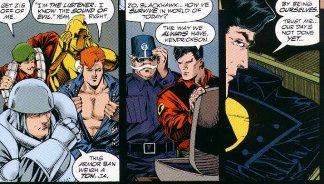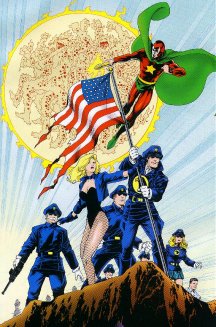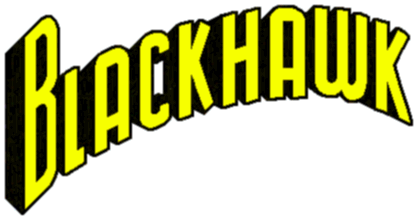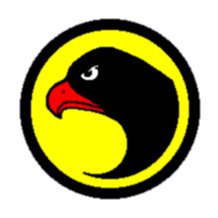
superhero-hood, in issue #8 of JLA Year One.

world's heroes in fighting the alien invaders, in issue #12.


 |
superhero-hood, in issue #8 of JLA Year One. |
 |
world's heroes in fighting the alien invaders, in issue #12. |
This twelve issue limited series tells the story of how the Justice League of America came into being, forged in the heat of battle against both an alien invasion and an immortal enemy. The story is set in the late 1960's and gives the serie's readers a chance to see some characters (Hal Jordan as the Green Lantern and Barry Allen as the Flash) who are no longer alive in current DC continuity. And it showed the founding members of the JLA adjusting to each other and, in the case of Aquaman and J'onn J'onnz - the Martian Manhunter, to Earth itself. This is an excellently told story written by Mark Waid (Kingdom Come) and Brian Augustyn. It is strikingly drawn by Barry Kitson and inked by Michael Bair. Ken Lopez is the letterer and Pat Garrahy the colorist. The plot is similar in many ways to an origin story told in JLA #144. In that story, the invading aliens were Martians from J'onn J'onnz' home planet. For Blackhawk fans, JLA Year One does two things. First, it brings them back in another appearance. Since we only see the Blackhawks in infrequent cameos now, each one is worthwhile. Second, it corrects what most Blackhawk fans consider the biggest mistake in their career, the attempt to modernize the team by turning them into costumed superheroes (in issues 228, 229, and 230). In issue #8 of JLA Year One, a full page is used to show Blackhawk talking to the team. In the top panel he says, "Gentlemen, we may be getting up in years...but the Blackhawks are still the finest fighting squadron the world has ever seen. However, when I said we needed upgrading to hold our own in an emerging world of superheroes, perhaps.....(we see Blackhawk facing the team dressed in their costumes as M'sieu Machine, the Leaper, Dr. Hands, the Golden Centurion, the Listener, and the Weapons Master)...perhaps I spoke too hastily." Then, as shown in the panel above, they trade their costumes for uniforms. The Blackhawks next appear in issue #11, and it's really Blackhawk Island that is featured in this issue as the invading aliens turn it into a prison for the Earth's superheroes. We see the Blackhawks' aircraft and buildings wrecked and in flames, and Blackhawk himself is shown among the prisoners on the title page. Near the end of this issue, the fledgling JLA tricks the invaders into taking them to Blackhawk Island where they free their fellow superheroes and begin to turn the tide of battle. Finally, the Black Knights appear again to good effect in the concluding issue, #12. They make their first appearance in a beautiful splash page with Black Canary and Starman (as shown in the panel above), where they have just defeated the aliens occupying Washington, DC. Later we see them flying their Grumman XF5F-1 Skyrockets in the company of Green Lantern in an attack on the aliens. Green Lantern, who in his other identity as Hal Jordan is a test pilot, remarks that the Skyrockets "are classics. What I wouldn't give to fly one of those...!" And Blackhawk replies that if they survive the fight they'll "set it up." I liked this series and I liked the use of the Blackhawks in it. But it does raise some questions. Ever since Howard Chaykin's mini-series appeared in 1987, all subsequent Blackhawk stories adhered to the revised continuity created by Chaykin. The original Blackhawks were even explained away as a comic book written by Natalie Reed, Lady Blackhawk, in Chaykin's continuity (see Blackhawk #1). The exception to this was Kingdom Come, where it was not clear whether or not the Blackhawks in that story were descended from Chaykin's Blackhawks. Like Kingdom Come, perhaps JLA Year One is outside the normal DC continuity. And, in fact, it's not completely consistent with the original series continuity since, in issue #242, we learned that the Blackhawks' secret identity costumes were destroyed by the Black Mask. Thus they didn't just decide to quit wearing them, as depicted in JLA Year One. But I actually prefer the story as told here. The Blackhawks make a conscious decision to return to their roots, which is more satisfiying than being forced to by a villain. And of course, the best part of this story is that it relegates all of the Chaykin derived continuity into a parallel universe and brings back the real Blackhawks. If this story is not the official DC continuity, it should be! I hope that all future appearances by the Blackhawks will follow from this story and not the Chaykin stories. [Editor's Note: Since I wrote this synopsis, several other cameo appearances have suggested that the orginal Blackhawks are again in DC continuity and Chaykin's is out. See Guns of the Dragon and Guy Gardner, Warrior.] As much as I liked this story, there were some glitches. When the Blackhawks make their first appearance, they are wearing the emblem that Chakyin created, not the emblem that was used in the 1967 Blackhawk comics. When they reappear in uniform in issue #12, Blackhawk is wearing an emblem similar to that of the 1950's (as seen at the top of this page, go to the Blackhawk Emblem page for to see the Chaykin and '67 emblems). This story is obviously supposed to invoke nostalgia for the superheroes of the past, with guest appearances by the JSA and other early characters, and no doubt that is why the Grumman Skyrocket is shown as the Blackhawks' aircraft. The creators of JLA Year One must have considered it the right aircraft to go with the team's original uniforms. But it is completely inappropriate for a story set in the Silver Age. The VTOL F-105 would have been the best choice, with the F-90C a good second choice. Thanks to Allen Wright for alerting me to this appearance of the Blackhawks in JLA Year One.
All characters, pictures, and related indicia on these pages are the property of DC Comics. All text is ©1998-2001 Dan Thompson, except where otherwise noted. This homepage is not intended to infringe on the copyright of DC Comics to its characters, but was created out of gratitude to all the wonderful writers, artists, and editors who created the Blackhawks.